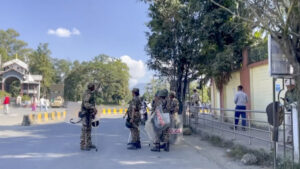Drying of Saraswati River led to decline of Harappan city, IIT Kharagpur study reveals

Kolkata,2 January (HS).A group of Indian researchers, led by a professor of Indian Institute of Technology(IIT),Kharagpur,has for the first time connected the decline of Harappan city of Dholavira to the ‘disappearance of a Himalayan snow-fed river which once flowed in the Rann of Kutch in Gujarat’.
According to the pain staking studies of the Research group, though ‘indirect attempts’ were made earlier to find out the river courses and its connection to climate and civilization in areas far away from these ancient cities, their efforts had now been able to connect the dots between the growth and decline of the Dholavira, the most spectacular and largest excavated Harappan city in India located in the Rann with this river which resembled the mythical Himalayan River Saraswati
The study which has recently been published online in prestigious ‘Wiley Journal of Quaternary Science’, is the outcome of the Herculean efforts of this research team comprising members of not only IIT Kharagpur,but also of those from the Archaeological Survey of India, Deccan College PGRI Pune, Physical research laboratory, and Department of Culture, Gujarat, who dated several archaeological remains from all the stages and inferred climate shifts leading to the rise and fall of the ancient city of Harappa.
“Our data suggest that prolific mangroves grew around the Rann and distributaries of Indus or other palaeochannels dumped water in the Rann near southern margin of Thar Desert. ‘This is the first direct evidence of glacial fed rivers quite like the supposedly mythological Saraswati, in the vicinity of Rann’, ,said Professor Anindya Sarkar of IIT Kharagpur who led the research.
Similarly, Dr. Ravi Bhushan and Navin Juyal from PRL, Ahmedabad dated the carbonates from human bangles, fish clothes and molluscan shells and found that the site was occupied from the Pre-Harappan period – about 5500 years ago to the late Harappan period of about 3800 years ago.
Researchers R.S. Bisht and Y.S. Rawat from the Archaeological Survey of India who originally excavated the site,concluded on the basis of degeneration of architecture, craftsmanship, and material culture that Dholavirans were probably the original inhabitants in the region,who had a fairly advanced level of culture even at its earliest stage.
‘They built spectacular city and survived for nearly 1700 years by adopting water conservation’, suggested the researchers,adding that the study also indicated that the city expanded till 4400 years followed by an abrupt decline nearly 4000 years ago.
Among others Arati Deshpande Mukherjee of Deccan College pointed out that the climatic evidences came from high resolution oxygen isotopes in snail shells Terebralia palustris which typically grew in mangroves and was a source of food for the Dholavirans.
According to another lead author of the paper and a PhD student at IIT Kharagpur Torsa Sengupta , ‘the early to Mature Harappan snail isotopes also suggested that the mangrove was fed by Glacier River debouching in the Rann of Kutch.
“Though the Dholavirans adopted excellent water conservation strategy by building dams, reservoirs and pipelines, they were pushed to the limit by a catastrophic Meghalayan mega-drought which collapsed the city. ‘Indeed Dholavira presents a classical case for understanding how climate change can increase future drought risk as predicted by the IPCC working group,said Prof. Sarkar adding
that their research also indicated that the collapse of Harappan Dholavira was near-synchronous to the decline at all the Harappan sites in India as well as societal collapse of Mesopotamia, Greece, China and the Old Kingdom of Egypt.






